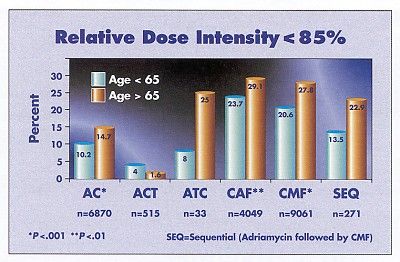Adjuvant Chemo Dose Reductions Frequent in Breast Cancer
SAN ANTONIO-Chemotherapy dose reduction occurs frequently despite the risk of a poorer long-term outcome when the full dose is not received, according to an analysis of 20,799 patients with early breast cancer who received adjuvant chemotherapy. Gary H. Lyman, MD, MPH, reported the results at the 23rd Annual San Antonio Breast Cancer Symposium, for the Awareness of Neutropenia in Chemotherapy (ANC) Study Group.
SAN ANTONIOChemotherapy dose reduction occurs frequently despite the risk of a poorer long-term outcome when the full dose is not received, according to an analysis of 20,799 patients with early breast cancer who received adjuvant chemotherapy. Gary H. Lyman, MD, MPH, reported the results at the 23rd Annual San Antonio Breast Cancer Symposium, for the Awareness of Neutropenia in Chemotherapy (ANC) Study Group.
In this retrospective study, 18.2% of patients receiving adjuvant chemotherapy had a low relative dose intensity, defined as less than 85% of the reference dose, said Dr. Lyman, director of the Cancer Center of Albany Medical College.
Dose delays of more than 5 days occurred in 43.4% of patients, and dose reductions occurred in 25.5%. Patients who were 65 years or older were more likely than younger patients to receive reduced doses.
The incidence of febrile neutropenia, a complication likely to result in a dose reduction or delay, was 5.9%. Although prophylactic G-CSF (Neupogen) can be used to prevent febrile neutropenia, it is expensive. The ANC Study Group is working to develop predictive models of treatment toxicity, including neutropenia, and to identify which patients would benefit most from prophylactic G-CSF.
Six chemotherapy regimens were represented in the nationwide survey of 1,243 community oncology practices (see Figure).

A large percentage of patients in the study, 43.6%, received cyclophosphamide, methotrexate, and fluorouracil (CMF). The rest received Adriamycin and cyclophosphamide (AC) (33%); cyclophosphamide, Adriamycin, and fluorouracil (CAF) (19.5%); Adriamycin and cyclophosphamide with Taxol (AC-T) (2.5%); sequential therapy consisting of Adriamycin followed by CMF (A-CMF) (1.3%); and Adriamycin, Taxol, and cyclophosphamide (A-T-C) (0.2%).
Dose Intensity by Regimen
Elderly patients were more likely than younger patients to have dose reductions in all of the chemotherapy regimens. However, the percentage requiring a dose reduction was highest for the CMF and CAF regimens.
For patients receiving CMF who were age 65 years or older, 27.8% received a low relative dose intensity, compared with 20.6% of the younger patients. For patients receiving CAF who were 65 years of age or older, 29.1% received a low relative dose intensity vs 23.7% of the younger patients. By comparison, in the group receiving AC, 14.7% of older patients vs 10.2% of younger patients received a low relative dose intensity.
Dose reductions varied among the newer regimens. For older patients receiving A-CMF, 22.9% received a low relative dose intensity, compared with 13.5% of the younger patients. Of the elderly patients receiving A-T-C, 25.0% received a low relative dose intensity vs 8.0% of the younger patients. In the group receiving AC-T, rates of reduced dose intensity were quite low for both groups: 1.6% for the older patients and 4.0% for the younger patients.
Febrile Neutropenia
The rate of febrile neutropenia was higher among older patients in some, but not all, of the chemotherapy regimens.
The study found that elderly patients who were given the AC, AC-T, and A-T-C regimens were more likely to experience high rates of febrile neutropenia, especially if they also had a low baseline WBC (white blood cell) count or ANC (absolute neutrophil count). However, none of the elderly patients with a low baseline WBC count or ANC receiving CMF had febrile neutropenia, although 6.7% of the younger patients did.
"The most likely explanation for this is that with the older regimens, like CMF, there was a much greater tendency to reduce dose intensity, particularly among the elderly," Dr. Lyman told ONI.
Published studies have shown that for CMF, 33% of those 65 years of age and over receive less than 85% of the reference dose intensity, compared with 22% of those under age 65, Dr. Lyman said.
For patients more than 80 years old, more than 60% receive less than 85% of the reference dose. "This simply means that we are less willing to strive for full dose intensity and its accompanying toxicity in elderly patients. However, it may also mean that we are not giving these patients the best opportunity for cure," Dr. Lyman said.
The ANC Study Group is a national coalition of investigators. Dr. Lyman, together with Jeffrey Crawford, MD, of Duke University, and David C. Dale, MD, of the University of Washington, Seattle, serve as the group’s steering committee. The group is funded, in part, by an unrestricted support grant from Amgen Corporation.
Newsletter
Stay up to date on recent advances in the multidisciplinary approach to cancer.